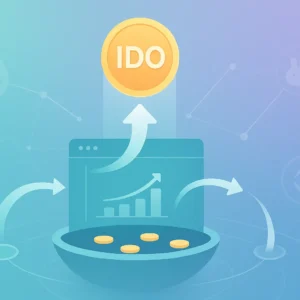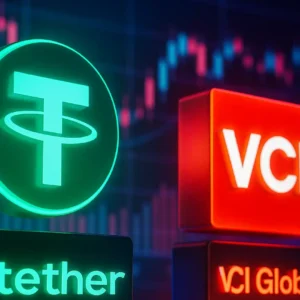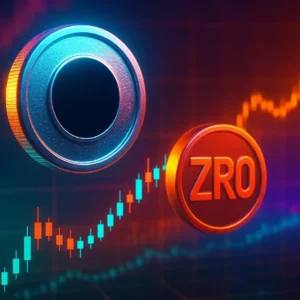An Initial DEX Offering (IDO) is a type of token launch where a new cryptocurrency project sells its tokens directly on a decentralized exchange (DEX) through automated smart contracts and liquidity pools. Unlike traditional launches on centralized exchanges, IDOs occur on platforms such as Uniswap, PancakeSwap, or Raydium, giving investors instant access and liquidity. This guide explains how IDOs function, their key advantages and risks, and how investors can find and participate in them effectively.
IDOs Explained
An Initial DEX Offering (IDO) is a decentralized crowdfunding model where blockchain projects launch and distribute their tokens directly through decentralized exchanges (DEXs). Instead of relying on centralized platforms or intermediaries, IDOs use automated smart contracts to handle token sales, distribution, and liquidity management transparently on-chain.
Unlike Initial Exchange Offerings (IEOs), which are conducted on centralized exchanges, or Initial Coin Offerings (ICOs), which typically occur on project websites, IDOs operate through decentralized liquidity pools. This means that token buyers interact directly with the smart contract, allowing immediate token trading and price discovery once the IDO goes live.
In essence, IDOs represent the next evolution of crypto fundraising—combining the open participation of ICOs with the instant liquidity and security features provided by decentralized finance (DeFi) protocols.
How Do IDOs Work?
1. Token Creation and Smart Contract Deployment
The project mints a new token and deploys it via a smart contract on a blockchain such as Ethereum, Solana, or BNB Chain. The contract defines the token’s supply, decimals, and transfer rules, and may include sale/vesting logic used during the IDO.
2. Liquidity Pool Setup
The team creates a liquidity pool (LP) on a DEX by pairing the new token with a base asset (typically USDT, ETH, or BNB). During the sale window, participants swap the base asset for the new token directly through this pool, enabling immediate price discovery and trading.
3. Launchpad or Platform Listing
Projects often host the sale on an IDO launchpad (e.g., PinkSale, DAO Maker, Polkastarter, BSCPad) that provides whitelists, KYC options, and anti-bot protections. Many launchpads use tier systems (based on staking or points) to allocate sale quotas, plus vesting schedules to release tokens over time and reduce dump risk.
4. Distribution & Post-Launch
After the sale, tokens are claimable via smart contract or automatically distributed to participant wallets. Teams typically lock a portion of LP tokens for a defined period to deter rug pulls and support liquidity, while post-launch activities include CEX/DEX listings, staking programs, and roadmap deliveries.
How to Participate in an IDO
Joining an Initial DEX Offering is a straightforward process once you understand how decentralized launchpads work. Below is a simple step-by-step guide to help you get started safely and efficiently.
1. Set Up a Crypto Wallet
Start by creating a non-custodial crypto wallet such as MetaMask or Trust Wallet. Make sure your wallet is configured for the correct network—Ethereum, BNB Chain, Solana, or whichever blockchain the IDO takes place on.
2. Fund Your Wallet
Purchase or transfer cryptocurrency (usually ETH, BNB, or USDT) into your wallet. These funds will be used to buy the new token during the IDO. Always leave a small amount for transaction fees, as each trade or contract interaction requires gas.
3. Connect to the Launchpad
Go to the chosen IDO launchpad platform and connect your wallet using the “Connect Wallet” button. Some launchpads may require you to stake their native token or join a whitelist before participating, so complete any eligibility steps in advance.
4. Join the Sale
Once the IDO starts, commit your funds by swapping your crypto for the new project token through the platform interface. Transactions are handled automatically by smart contracts, ensuring transparent allocation and recording of all purchases on the blockchain.
5. Claim Tokens Post-IDO
After the sale ends and liquidity is added to the DEX, you can claim your purchased tokens directly from the launchpad or the project’s claim portal. Once tokens appear in your wallet, you may choose to hold, trade, or stake them based on the project’s roadmap and market conditions.
IDO vs ICO vs IEO
While IDOs, ICOs, and IEOs all serve the same purpose of helping new crypto projects raise funds and distribute tokens, they differ significantly in how they are structured, managed, and accessed by investors. The table below highlights the key distinctions among the three models.
| Feature | ICO | IEO | IDO |
|---|---|---|---|
| Platform | Project’s own website or custom platform | Centralized exchange (e.g., Binance, OKX) | Decentralized exchange (e.g., Uniswap, PancakeSwap) |
| KYC Required | Rarely | Yes | Sometimes (depends on launchpad) |
| Accessibility | Open to all investors globally | Restricted to exchange users | Open to anyone with a crypto wallet |
| Fund Handling | Directly by project team | Managed by exchange as intermediary | Automated through smart contract |
| Risk Level | High (no oversight) | Moderate (exchange vetting) | Moderate to high (depends on project) |
| Listing Fees | Low | High | Low |
| Liquidity After Launch | Not guaranteed | Available on exchange | Instant trading via DEX liquidity pools |
In short, ICOs prioritize accessibility, IEOs focus on centralized security, and IDOs balance both worlds through decentralization and transparency—though investors must still perform their own due diligence before participating.
Key Features of IDOs
Initial DEX Offerings combine the open participation of ICOs with the automation and transparency of decentralized finance. Below are the main features that define IDOs and make them a popular fundraising model for blockchain startups.
- Decentralized Access: Anyone with a crypto wallet can join an IDO without needing to register on a centralized exchange or pass through intermediaries, supporting open and global participation.
- Immediate Liquidity: Tokens become tradable as soon as the sale ends, since liquidity pools are created instantly on the hosting DEX. This ensures smoother price discovery and early market activity.
- Smart Contract Automation: Every step—from token allocation to fund transfer—is executed via smart contracts, reducing manual errors and ensuring transparency throughout the process.
- Community Governance: Many IDO launchpads involve their communities in decision-making, allowing token holders to vote on which projects will be launched or supported next.
- Low Entry Barriers for Projects: IDOs are cheaper and faster to organize than exchange listings, as they avoid large fees and lengthy approval procedures, making them ideal for smaller teams and startups.
- Cross-Chain Support: Modern launchpads often operate on multiple blockchains such as Ethereum, BNB Chain, Solana, and Polygon, giving projects more flexibility and a broader investor reach.
Advantages and Risks of IDOs
Like any investment model, Initial DEX Offerings (IDOs) have both strengths and weaknesses. The table below summarizes their key advantages and associated risks to help investors make informed decisions before participating.
| Advantages | Risks & Challenges |
|---|---|
| Open Participation: Anyone with a crypto wallet can join, promoting inclusivity and global access. | Rug Pulls and Scams: Fraudulent teams may create fake projects and vanish with investors’ funds if liquidity isn’t locked. |
| Instant Liquidity: Tokens become tradable immediately after launch through DEX liquidity pools. | Extreme Volatility: Prices can rise or fall dramatically within minutes after trading starts. |
| Low Fees: No high exchange listing costs; smart contracts handle sales automatically. | Smart Contract Vulnerabilities: Poorly written or unaudited code can be exploited by hackers. |
| Transparency: On-chain transactions allow investors to verify fund flow and token allocation in real time. | Lack of Oversight: Many IDOs operate without regulatory supervision or KYC requirements, increasing exposure to fraud. |
| Community Engagement: Investors can join early and influence governance or staking decisions. | Bot Sniping: Automated bots can buy large portions of tokens instantly, leaving smaller investors at a disadvantage. |
| Cross-Chain Access: IDOs run across multiple networks, expanding investor reach and interoperability. | Short-Term Hype: Some projects attract speculative traders seeking quick profits, leading to post-launch dumps. |
How to Find IDOs Before They Launch
Discovering high-quality IDOs early is key to maximizing potential returns and avoiding oversubscribed or scam projects. Below are the most effective ways to spot upcoming Initial DEX Offerings before they go public.
1. Monitor IDO Launchpads
Most legitimate IDOs take place on established decentralized launchpads such as DAO Maker, BSCPad, Polkastarter, PinkSale, or Solanium. These platforms publish schedules and whitelist details for upcoming sales. Subscribing to their newsletters or following their official channels ensures you never miss an announcement.
2. Use IDO Calendars and Aggregators
Dedicated crypto aggregators like BestICOlist.com track upcoming IDOs, ICOs, and presales across multiple networks. These tools let you filter projects by blockchain, category, and launch stage, helping you find new opportunities quickly.
3. Follow Project Social Channels
New crypto projects frequently announce their IDO details through Twitter (X), Telegram, and Discord communities. Joining these groups allows investors to get firsthand information on whitelist openings, vesting schedules, and tokenomics updates.
4. Check Smart Contract Audits
Before investing, confirm that the project has undergone a professional audit by services like Certik, SolidProof, or Coinsult. Audited smart contracts significantly reduce the risk of exploits or fraudulent code.
5. Research the Team and Whitepaper
Review the project’s whitepaper to understand its utility, tokenomics, and roadmap. Look for doxxed (public) team members with verifiable experience, as transparency often indicates stronger credibility and commitment to long-term goals.
How to Identify a High-Quality IDO
Not every IDO leads to long-term success, so distinguishing legitimate and promising projects from risky ones is crucial. Use the following checklist to evaluate whether an IDO is worth your investment.
- Verified Smart Contract Audit: Check if the project’s code has been audited by trusted firms like Certik, Hacken, or Coinsult. A public audit report confirms that the smart contract is secure and transparent.
- Transparent and Doxxed Team: Look for teams that disclose their identities, LinkedIn profiles, and prior experience. An anonymous or unverifiable team is a potential red flag for scams or rug pulls.
- Clear Tokenomics: Review the project’s token allocation—how much goes to the team, community, liquidity, and staking rewards. Balanced tokenomics with reasonable vesting periods indicate healthy project planning.
- Strong Use Case and Roadmap: A credible IDO should solve a real problem or offer a practical application in DeFi, gaming, or Web3. Check if the roadmap includes realistic milestones rather than vague promises.
- Liquidity Lock and Vesting: Confirm that a significant portion of liquidity is locked for several months post-launch. Projects that lock LP tokens help reduce the risk of rug pulls and build investor confidence.
- Community Engagement: Examine the project’s activity on social media and its community channels. A genuine, growing, and active user base often signals authenticity and strong long-term interest.
- Partnerships and Backers: Reliable partnerships with known blockchain ecosystems, venture firms, or launchpads can strengthen a project’s legitimacy and future prospects.
Popular IDO Launchpads in 2025
IDO launchpads act as gateways between new crypto projects and investors, providing the infrastructure for token sales, whitelisting, and community participation. Below are some of the most established and trusted IDO platforms in 2025.
- DAO Maker: One of the most reputable multi-chain launchpads, DAO Maker offers a structured fundraising environment with extensive due diligence and strong community governance. It supports Ethereum, BNB Chain, and other major networks.
- BSCPad: Known for its user-friendly interface and transparent tier system, BSCPad focuses on BNB Chain projects. It provides fair allocation models that reward long-term holders of its native BSCPAD token.
- Polkastarter: A pioneer in the IDO space, Polkastarter enables cross-chain token sales with built-in KYC, whitelist management, and anti-bot measures. It’s widely used for projects in DeFi, GameFi, and metaverse sectors.
- PinkSale: A fully decentralized launchpad where anyone can create and host an IDO with minimal requirements. PinkSale is especially popular among meme coin and community-driven projects for its accessibility and simplicity.
- Solanium: Built specifically for the Solana ecosystem, Solanium offers a smooth IDO experience with integrated staking, governance, and portfolio management tools. It caters to high-speed, low-fee launches.
- TrustPad: A multi-chain platform supporting Ethereum, Polygon, and Avalanche, TrustPad focuses on security and investor protection. All projects undergo KYC verification and smart contract audits before listing.
- Seedify: A gaming and metaverse-oriented launchpad, Seedify helps fund and incubate blockchain gaming startups. It provides NFT support, staking rewards, and community incentives for early participants.
Why IDOs Are Gaining Popularity
In recent years, IDOs have become one of the most widely adopted fundraising models in crypto. Their growth is fueled by the expansion of decentralized finance (DeFi), increased investor education, and a shift toward trustless and transparent systems. Here are the main reasons IDOs continue to attract both developers and investors:
- Decentralization and Control: IDOs eliminate intermediaries, allowing projects to manage their token sales independently while giving investors direct access to participation.
- Integration with DeFi Ecosystems: IDOs naturally connect with decentralized applications, liquidity pools, and staking protocols, offering immediate utility for tokens after launch.
- Transparency and On-Chain Verification: All transactions, token allocations, and liquidity movements occur on the blockchain, ensuring full visibility for investors and reducing manipulation risks.
- Fairer Launch Models: Compared to private sales or exchange offerings, IDOs promote more democratic participation through community whitelists and anti-bot measures.
- Global Accessibility: Because IDOs operate on decentralized exchanges, participation is borderless — anyone with an internet connection and a crypto wallet can join.
- Lower Costs for Projects: Without centralized listing fees or exchange commissions, IDOs allow projects to raise capital more efficiently and allocate more funds to development.
- Growing Institutional Interest: As DeFi infrastructure matures, even professional investors and funds are exploring IDO platforms for early exposure to promising blockchain startups.
Potential Future of IDOs
The future of Initial DEX Offerings looks promising as the decentralized fundraising landscape continues to mature. Many experts believe that IDOs will evolve through deeper integration with advanced technologies such as artificial intelligence for automated token vetting and project scoring. AI-driven analytics could help identify red flags, improve investor safety, and streamline launchpad approval processes.
Another major trend shaping the future of IDOs is the rise of cross-chain liquidity solutions. As blockchain interoperability grows, IDO platforms are expected to support seamless fundraising across multiple networks, allowing projects to reach a wider range of investors and liquidity sources without being confined to a single ecosystem.
At the same time, regulatory discussions around decentralized fundraising are likely to intensify. Governments and blockchain organizations may introduce frameworks that balance investor protection with the core principles of decentralization. This could bring more legitimacy and institutional participation to IDO platforms.
Finally, the next generation of fundraising models may combine the best aspects of IEOs and IDOs — centralized oversight for compliance and decentralized trading for accessibility. These hybrid launch models would enable greater transparency, efficiency, and scalability, marking a new era in crypto project fundraising.
Final Thoughts
Initial DEX Offerings (IDOs) have revolutionized the way blockchain startups raise capital by introducing a decentralized, transparent, and inclusive model for token distribution. They empower projects to connect directly with investors while bypassing intermediaries, creating a fairer and more efficient fundraising environment. For investors, IDOs offer early access to emerging crypto assets, though this opportunity comes with notable risks such as volatility, scams, and unverified projects.
Despite these challenges, IDOs continue to grow as part of the broader decentralized finance ecosystem. The combination of smart contract automation, global accessibility, and community-driven participation has established IDOs as a key innovation in crypto fundraising. As regulatory clarity improves and technology evolves, the IDO landscape is expected to mature further, offering both greater investor protection and broader adoption across the Web3 economy.
Ultimately, success in IDO investing depends on careful research, risk management, and a deep understanding of project fundamentals. By staying informed, using verified launchpads, and prioritizing transparency, investors can navigate this rapidly changing space with confidence.
34-year-old writer and content strategist with a passion for technology, culture, and storytelling. Over the past four years, he’s taken a strong interest in the crypto sphere, diving deep into blockchain trends, meme coin madness, and the evolving DeFi space.
0 comments
Related post
Table of content










